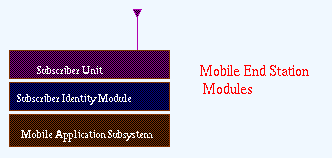
Mobile End Station (M-ES)
Contributed by Yi-Bing Lin
A
CDPD
user communicates with the CDPD network by using the M-ES. The physical
location of M-ESs may change from time to time, but continuous network access
is maintained. An M-ES may be
- a credit card verification units installed in a taxi,
- a personal communicator or a PDA,
- a CDPD modem for personal computer, palmtop, and laptop
(which may incorporate a cellular transceiver and re-chargeable batteries
in a palm-sized, serially-connected unit to a PC).

The M-ES consists of three parts:
- The subscriber unit is used to access the radio interface.
- The subscriber identity module contains information to identify
a subscriber (for the security purposes).
- The mobile application subsystem
provides the M-ES application functionality, which can be a personal computer
or a simple telemetric tool.
A sleep mode is provided in CDPD to allow an idle M-ES to shut off
power for a predefined period. To ``wake up'' the M-ES,
the MDIS
periodically broadcasts a notification message to provide the list of M-ESs
that are receiptants of the frames queued in the MDIS. The M-ES periodically
activates its receiver to listen to the broadcast notification message. If
its name is found in the list, the M-ES leaves the sleep mode by sending a
message to the MDIS. With this mechanism, the battery life of the M-ES can
last longer (12-hour battery life with CDPD power-saving mode has been
reported in the commercial products).
An M-ES may repeatedly transmits long bursts.
To prevent this channel hogging situation, a minimum time period is
defined between two bursts of an M-ES to ensure that other M-ESs have the
chance to access the reverse link.




JPL's Wireless Communication Reference Website
©
Yi-Bing Lin (Author) and
Jean-Paul M.G. Linnartz (Ed.), 1996.






![]()